Journal of the Ceramic Society of Japan
vol. 133, no.12, 2025
◆Special Article-Academic Achievements◆
The 78th CerSJ Awards for Academic Achievements in Ceramic Science and Technology: Review
A review of simulation, characterization, and informatics in inorganic materials
 https://doi.org/10.2109/jcersj2.25121
https://doi.org/10.2109/jcersj2.25121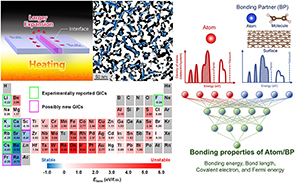
Teruyasu Mizoguchi
713
Ceramic materials exhibit a wide range of functional properties that are strongly influenced by their atomic structures, chemical bonding, and lattice defects, including interface and surface. A deep understanding and precise control of these factors are essential for advancing materials design. In this review, I summarize recent progress from my group on computational, experimental, and informatics approaches aimed at elucidating structures and defects, as well as guiding the development of inorganic materials. First, I describe defect simulations accelerated by machine learning. Bayesian optimization was shown to drastically reduce the computational cost of interface structure determination, identifying stable interface configurations with only a fraction of the calculations required by conventional approaches. In addition, adsorption properties at surfaces were effectively predicted using descriptors derived from the individual electronic structures of isolated systems, demonstrating a new pathway to high-throughput surface analysis. Next, I highlight nano-scale characterization of oxides using electron microscopy and spectroscopy. We demonstrated that the nano-scale characterization enables quantitative determination of coordination number distributions in disordered glass systems. High-temperature in-situ imaging was used to track the evolution of phase separation in glass, and a high-resolution analysis revealed the local thermal expansion behavior at the crystalline interface at the nano-scale. Finally, I introduce the data-driven materials discovery of layered intercalated compounds. By analyzing more than 9,000 host–guest combinations, we established a quantitative stability rule based on hard-soft acid-base interactions and Coulombic size effects, which can also predict the stability of previously unreported compounds. Furthermore, we identified promising graphite intercalation compounds expected to exhibit exotic properties such as superconductivity. Consequently, I emphasize the importance of methodological developments as essential foundations for advancing ceramic science. Looking forward, the convergence of simulations, characterizations, and informatics, together with emerging artificial intelligence (AI) technologies, is expected to open new directions for materials research.
The 79th CerSJ Awards for Academic Achievements in Ceramic Science and Technology: Review
Development of electronically conducting ceramic nanoparticles toward the application of electrocatalysts for polymer electrolyte fuel cells and water electrolyzers
 https://doi.org/10.2109/jcersj2.25117
https://doi.org/10.2109/jcersj2.25117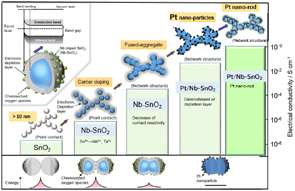
Katsuyoshi Kakinuma
735
High-durability, high-activity electrocatalysts for both polymer electrolyte fuel cells and water electrolyzers are developed by utilization of electronically conducting ceramic nanoparticles. These electrocatalysts require the function of a gas diffusion electrode, which in turn requires electronically conducting pathways, gas diffusion pathways, high surface area and durability at high electrode potentials. The electronically conducting ceramic nanoparticles should be modified to mitigate the resistivity originating from gas adsorption, quantum size effects, and interfacial contact between nanoparticles. The specific microstructure, interface structure, electronic state and crystallinity of the electronically conducting ceramic nanoparticles should also be controlled toward the specific application of the electrocatalyst. These electronically conducting ceramic nanoparticles have demonstrated promising possibilities toward their application in green hydrogen technology.
◆Full papers◆
Proton conduction and full hydration of BaSc0.6Lu0.2Mo0.2O2.8
 https://doi.org/10.2109/jcersj2.25094
https://doi.org/10.2109/jcersj2.25094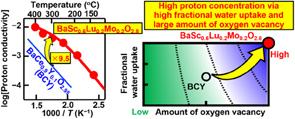
Ryo Maeda, Kei Saito, Kotaro Fujii, Takashi Honda and Masatomo Yashima
741
Ceramic proton conductors have attracted increasing attention due to their potential to improve the efficiency of electrochemical devices, such as fuel cells. BaSc0.8Mo0.2O2.8 exhibits high proton conductivity, however, it is not fully hydrated, resulting in a low proton carrier concentration. Here, we report the full hydration and high proton concentration of a new material, large-sized Lu-substituted BaSc0.8Mo0.2O2.8 (BaSc0.6Lu0.2Mo0.2O2.8). Due to the larger ionic radius of Lu3+ than Sc3+, the lattice volume of BaSc0.6Lu0.2Mo0.2O2.8 was larger than that of BaSc0.8Mo0.2O2.8, which can be responsible for the full hydration and higher water uptake of BaSc0.6Lu0.2Mo0.2O2.8 compared with BaSc0.8Mo0.2O2.8. The bulk conductivity of BaSc0.6Lu0.2Mo0.2O2.8 (0.01 S cm−1 at 400 °C) was higher than that of the leading materials such as BaZr0.8Y0.2O2.9 and BaCe0.9Y0.1O2.95 (e.g., 19 times higher than BaCe0.9Y0.1O2.95 at 243 °C). This is attributable to the higher proton concentration 0.40 of BaSc0.6Lu0.2Mo0.2O2.8 compared with 0.17 of BaZr0.8Y0.2O2.9 and 0.08 of BaCe0.9Y0.1O2.95. The bulk conductivity of BaSc0.6Lu0.2Mo0.2O2.8 was lower than that of BaSc0.8Mo0.2O2.8 and BaSc0.8W0.2O2.8 due to its lower proton diffusion coefficient D. The D of BaSc0.6Lu0.2Mo0.2O2.8 exhibited a non-Arrhenius behavior, and its activation energy for D increased with decreasing temperature, which is attributable to proton trapping.
Chemical heterogeneity-driven diffused phase transitions in Ba(Zr,Ti)O3 ceramics: Role of incomplete solid-state reactions
 https://doi.org/10.2109/jcersj2.25105
https://doi.org/10.2109/jcersj2.25105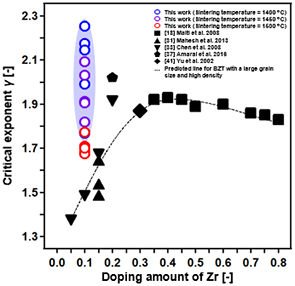
Takumi Nozaki, Shaoxiong Xie, Udo Eckstein, Alexander Martin, Kyle G. Webber, Tadachika Nakayama and Ken-ichi Kakimoto
750
Chemical heterogeneity in Ba(Zr0.1Ti0.9)O3 (BZT) ceramics was formed by an incomplete solid-state reaction. XRD and SEM-EDS analyses revealed the calcined powder contained a mixture of BZT particles with varying concentrations of Zr. Such particles inhibited grain growth and resulted in diffuse phase transition in BZT ceramics due to higher grain-boundary density and chemical heterogeneity. As the chemical heterogeneity was reduced by increasing calcination and sintering temperatures, the grain size increased from 1.65 to 38.5 µm, resulting in their dielectric behavior changing from diffuse phase transition to a proper ferroelectric. These results indicate that the incomplete solid-state reaction plays an important role in microstructure evolution and electrical properties in BZT-based ceramics synthesized via solid-state reaction involving ZrO2.
“Magnesia-stabilized β-wollastonite” inhibiting transformation from β to α in the region of high temperature: Transition enthalpy by calorimetry
 https://doi.org/10.2109/jcersj2.25131
https://doi.org/10.2109/jcersj2.25131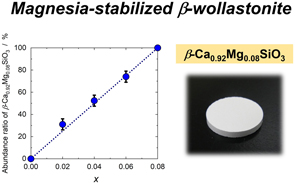
Natsuki Hosoya and Hirotaka Fujimori
759
Wollastonite has been widely studied as a ceramic raw material of calcium silicate (CaSiO3). Recently, Mg-doped wollastonite has attracted increasing attention due to its enhanced mechanical, insulative and bioactive properties. However, synthesizing single phase Mg-doped wollastonite is not easy because wollastonite undergoes crystal phase transition from β-CaSiO3 to α-CaSiO3 at around 1200 °C. Therefore, it is important to establish practical synthesis method of Mg-doped wollastonite for future application studies. In this study, β-Ca0.92Mg0.08SiO3 was successfully synthesized at 1300 °C by two-step sintering of Mg-containing xonotlite, which inhibits the transformation from β to α at high temperatures. The first step facilitates complete Mg diffusion into β-CaSiO3, while the second step promotes Mg diffusion from diopside (CaMgSi2O6) to β-CaSiO3 without occurring β-α phase transformation. Owing to the stabilization of the low-temperature phase at high temperatures through magnesia addition, the material was named “magnesia-stabilized β-wollastonite (MSW)” in reference to yttria-stabilized zirconia (YSZ).
Understanding capacity degradation in sulfurized polyacrylonitrile (SPAN) electrodes insights from transmission electron microscopy
 https://doi.org/10.2109/jcersj2.25118
https://doi.org/10.2109/jcersj2.25118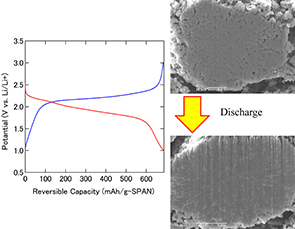
Jiong Ding, Kenji Kakiage and Shigeo Mori
765
Sulfurized polyacrylonitrile (SPAN) is considered a promising sulfur cathode material to suppress the shuttle effect, as the active sulfur in SPAN is atomically dispersed and covalently bonded to the conductive skeleton, thereby eliminating the presence of elemental sulfur. This structure significantly reduces the dissolution of lithium polysulfides into the electrolyte during cycling. To enhance our understanding of the charge–discharge mechanism of SPAN, this study employed transmission electron microscopy (TEM) to investigate and analyze the microstructural changes in SPAN. Our findings revealed that SPAN particles undergo repeated expansion and contraction, leading to the expansion and closure of internal cracks. Li2S nanocrystals appear in SPAN with lithiation and remain even when SPAN is fully delithiated. In parts of regions, sulfur migrates and accumulates at crack boundaries in the SPAN particles, forming Li2S nanocrystals with sizes ranging from 20 to 50 nm. These Li2S nanocrystals also persist even when SPAN is fully delithiated. The accumulation of sulfur and Li2S at boundaries hinders lithium-ion transport, preventing lithiation of the internal SPAN regions and causing electrochemically inactive zones. Consequently, this contributes to capacity fading and limits the overall battery performance.
Fabrication of three-dimensional alumina ceramics by direct ink writing
 https://doi.org/10.2109/jcersj2.25113
https://doi.org/10.2109/jcersj2.25113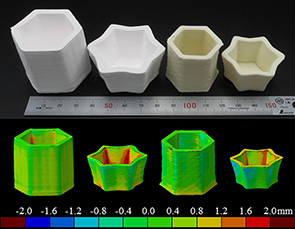
Yoshitaka Kataoka and Kozo Yokota
772
We investigated the fabrication of three-dimensional molding of porous bodies and dense bodies of alumina ceramics using direct ink writing (DIW). Ceramic pastes were prepared by adding appropriate amounts of binder, plasticizer, and water to the starting raw material of alumina powder, and various shapes were molded. The characteristics of the molded and sintered bodies were evaluated. Improved shape retention was observed with the addition of polyethylene glycol and an increase in the solid content. However, if these become excessive, extrusion difficulties and delamination of the laminated interface occur; therefore, it is necessary to reduce the apparent viscosity of the ceramic paste within a range that does not cause deformation. It was suggested that porous and dense bodies of three-dimensional alumina ceramics with shapes close to the design could be fabricated using DIW by adjusting the CAD models to account for anisotropic sintering shrinkage.
◆Technical report◆
Preparation, crystal structure, crystal morphology and ionic conductivity of two-dimensional layered M2ZrP2O8·nH2O (M: Li, Na, K, Rb, and Cs)
 https://doi.org/10.2109/jcersj2.25111
https://doi.org/10.2109/jcersj2.25111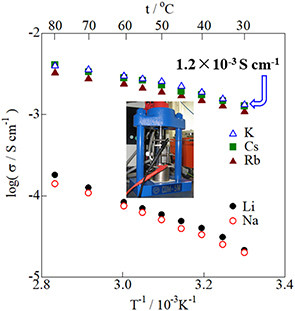
Susumu Nakayama
778
In two-dimensional protonated layered Zr phosphates, H+ ion exchange with monovalent alkali metal ions (M+) of smaller atomic radii (e.g., Li+, Na+) in aqueous solution proceeds much more easily than with larger ions (e.g., K+, Rb+, and Cs+). Therefore, this study investigated the preparation of M2ZrP2O8·nH2O (M: Li, Na) and M2ZrP2O8·nH2O (M: K, Rb, Cs) powders via ion substitution—from H+ to Li+ and Na+ in γ-Zr(PO4)(H2PO4)-2H2O in aqueous solution—and solid-state reactions, respectively. The prepared M2ZrP2O8·nH2O (M: Li, Na) was monoclinic with a thin plate-like crystal morphology, whereas M2ZrP2O8·nH2O (M: K, Rb, Cs) was tetragonal with a thick plate-like crystal morphology. Further analyses revealed (002) or (001) peaks, indicating an interlayer distance of approximately 5–10°. Moreover, the interlayer distance of M2ZrP2O8·nH2O (M: Li, Na) exceeded that of M2ZrP2O8·nH2O (M: K, Rb, Cs). Finally, the ionic conductivity of M2ZrP2O8·nH2O (M: K, Rb, Cs) at 30–80 °C exceeded that of M2ZrP2O8·nH2O (M: Li, Na) by approximately 1.5 orders of magnitude, while the apparent activation energy for ionic conduction was lower. The ionic conductivities of M: K, Rb, and Cs at room temperature were found to be 1.2 × 10−3, 9.1 × 10−4, and 1.3 × 10−3 S·cm−1, respectively.
◆Notes◆
Effect of Mn doping into the octahedral WO6 unit on the yellow-orange coloration of triclinic LiCeW2O8
 https://doi.org/10.2109/jcersj2.25135
https://doi.org/10.2109/jcersj2.25135
Yo Shimura and Shinji Tamura
784
A novel environmentally friendly inorganic yellow-orange pigment, LiCeW2−xMnxO8−δ (0 ≤ x ≤ 0.07), was synthesized and its optical and color properties were investigated. By partially substituting Mn, a promising source of orange-red coloration, into the octahedrally coordinated W site of the LiCeW2O8 host lattice, the absorption intensity of d–d transitions associated with W and Mn in octahedral coordination was modulated, thereby enabling control over light reflection in the visible spectrum. X-ray photoelectron spectroscopy and Rietveld refinement suggested that the electronic states of the constituent elements may have influenced the d–d transition absorption intensities of W(6−δ)+ and Mn(4−δ)+ species, thereby altering the overall light absorption behavior. As a result, the reflectance of LiCeW1.97Mn0.03O8−δ was selectively enhanced in the red region, yielding the most vivid and bright orange pigment.
Space-group determination by combining deep learning-based prediction and Le Bail analysis: Perovskite structure as an example
 https://doi.org/10.2109/jcersj2.25108
https://doi.org/10.2109/jcersj2.25108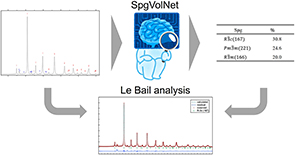
Naoya Ishida, Hiroyuki Ozaki, Tsukasa Nagai and Tetsu Kiyobayashi
788
When dealing with crystalline inorganic compounds, a great deal of skill and expertise are entailed in constructing an initial input structure for the Rietveld analysis from their powder X-ray diffraction (XRD) profiles. For newly synthesized materials in particular, determining the space group to which the compound belongs, the first step to begin the Rietveld analysis, often relies on experimentalists’ intuition and experience. Occasionally, we need to try several candidate space groups through trial and error, which takes a significant amount of time. To streamline this initial step, this study demonstrates a scheme for determining the valid space group and lattice parameters of an unknown compound using the Le Bail analysis. This scheme uses a deep-learning model, SpgVolNet, developed in our previous study to predict candidate space groups from an experimental XRD profile. Although we had known the structure of the model compound in this study, perovskite-type La0.6Sr0.4Mn0.9Co0.1O3, we assumed it to be “unknown.” The SpgVolNet predicted that this compound belongs to R−3c with the highest probability. Le Bail analysis under R−3c and several other plausible space groups led us to the “correct” conclusion that the compound indeed belongs to R−3c with reliable lattice parameters.
◆Announcement◆
Call for a Guest Editor for the Feature
 https://doi.org/10.2109/jcersj2.133.A12-1
https://doi.org/10.2109/jcersj2.133.A12-1A12-1
◆Vol. 133 (Nos. 1–12) Index◆
Annual Table of Contents
 https://doi.org/10.2109/jcersj2.133.I-1
https://doi.org/10.2109/jcersj2.133.I-1I-1
Author Index
 https://doi.org/10.2109/jcersj2.133.I-8
https://doi.org/10.2109/jcersj2.133.I-8I-8
© Copyright by The Ceramic Society of Japan

